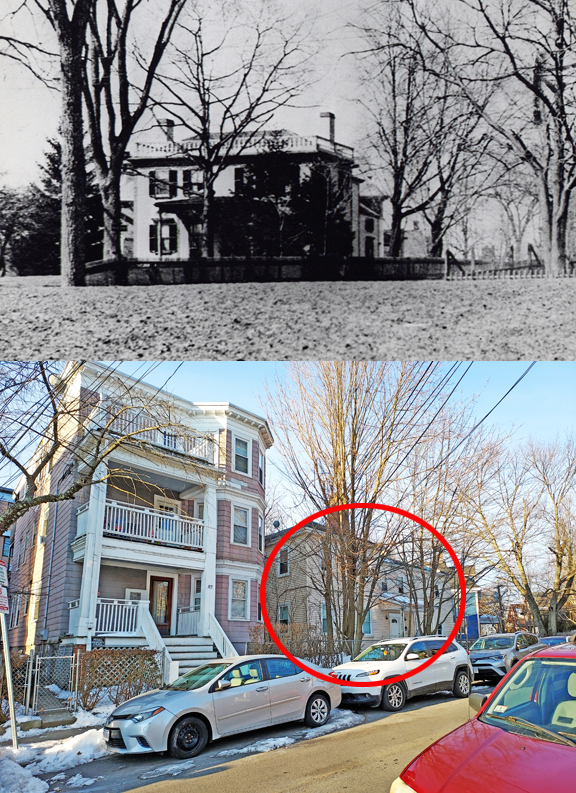
Dorchester Illustration 2556 Bailey Conant House
The top photograph in today’s email is a photograph of 77 Bailey Street as seen from Dorchester Avenue in the late nineteenth century. By 1910, the land between the Bailey house and Dorchester Avenue was subdivided for three three-deckers, two facing Dorchester Avenue and another facing Bailey Street, right next to the front of the old Bailey house. The entrance to 77 Bailey Street was changed from the house’s former front, facing Dorchester Avenue, to a new entrance on Bailey Street. The bottom photograph shows the modern streetscape with the yellow 77 Bailey Street house sandwiched between a three-decker on the left and another multi-family house on the right.
John Bailey acquired 6 ¼ acres of land in 1824. He may have built a house there, or he may have acquired land with an already-existing house. He was elected that year to the U.S. House of Representatives from the 10th Congressional District, but the House refused to seat him, because he was not a resident of that district. He had moved to Dorchester. The house is represented on the 1831 map of Dorchester and Milton drawn by Edmund J. Baker.
Bailey was born on 1786 in the part of Stoughton that became Canton in 1797. Bailey graduated from Brown University and was employed as a tutor and librarian in Providence from 1807 to 1814. Bailey was a poet, and two of his poems and a play are in the collection of the John Hay Library, Brown University.
John Bailey was elected to the U.S. House of Representatives from the Massachusetts 10th Congressional district, serving from 1814 to 1817. Bailey was elected a member of the American Antiquarian Society in 1816. He became the clerk in the Department of State in Washington, D.C., from 1817-1823. He presented credentials as a Member-elect to the Eighteenth Congress, but the election was contested on the ground that he was not a resident of the district he purported to represent, and by resolution of March 18, 1824, the House declared he was not entitled to the seat. Bailey was subsequently elected as an Adams-Clay Republican to fill the vacancy in the seat that he had been denied; reelected as an Adams supporter to the Nineteenth and Twentieth, and as an Anti-Jacksonian in the Twenty-first Congress. He was chair of the Committee on Expenditures in the Department of State during the Nineteenth Congress. John Bailey appeared in the 1830 U.S. Census as a resident of Dorchester. He was not a candidate for re-nomination in 1830, but he served as a member of the Massachusetts State senate from 1831 to 1834. He was the unsuccessful Anti-Masonic candidate for Governor in 1834. John Bailey died in Dorchester, Mass., June 26, 1835. His wife, Ann, died in late December of the same year.
Boston was very densely populated in the 1860s, and the anticipation of Dorchester’s annexation to Boston on January 1, 1870, brought attention to Dorchester. The excitement of the possibilities of residential development led to the creation of subdivisions of large tracts of land in the late 1860s and the early years of the 1870s.
Bailey and Fuller Streets were developed in the early 1870s. Benjamin B. Newhall acquired the eastern third of the area, which comprised the estate of John Bailey, and Enoch P. Fuller, Newhall’s father-in-law, acquired the western two-thirds of the area, which was formerly a property owned by the Robinson family. Together, Newhall Fuller, his father-in-law, engaged surveyor Luther Briggs to prepare a subdivision, dated April 1, 1870, showing proposed Bailey and Fuller Streets and dividing the land into generally rectangular lots, nearly all of which were between 10,000 and 11,000 square feet.
During the early years of the subdivision, Benjamin Newhall moved into the old Bailey house. He and his father-in-law each built houses on some of the lots, and they sold lots to other people, either for immediate construction or for investment.
In 1882, The Conant family moved into 77 Bailey Street. James S. Conant was in real estate. His son,
James Bryant Conant, was born in 1893. He attended the Roxbury Latin School, then Harvard College. He earned a PhD in Chemistry from Harvard University.
James Bryant Conant became president of Harvard University and during World War I, he served in the U.S. Army as a chemist, working on the development of poison gases. He was a proponent of the Scholastic Aptitude Test (SAT) and of co-education. For his accomplishments in chemistry, he was awarded the American Chemical Society’s Nichols Medal in 1932, Columbia University’s Chandler Medal in 1932, and the American Chemical Society’s highest honor, the Priestley Medal, in 1944.
In 1940, he was appointed to the National Defense Research Committee and became chair in 1941. He oversaw the development of synthetic rubber and the Manhattan Project, which developed the first atomic bombs. He was part of the committee that advised President Harry Truman to use atomic bombs on Japan. He served on the General Advisory Committee of the Atomic Energy Commission. As part of that committee, he urged the president not to develop a hydrogen bomb. He retired from Harvard in 1953 and became the United States High Commissioner for Germany and later Ambassador to West Germany after the re-establishment of a recognized national government there. In 1957, he returned to the United States and wrote several books about the education system in this county. He died in 1978.
